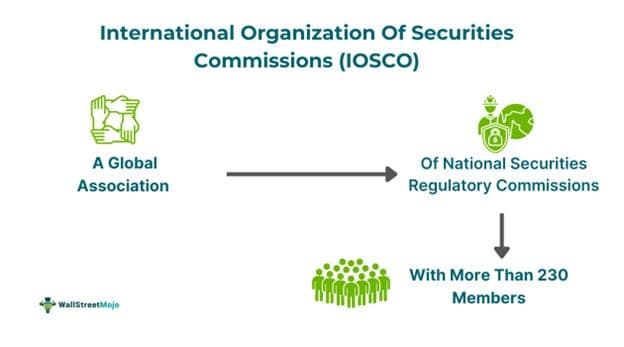International Organization of Securities Commissions
Table Of Contents
What Is An International Organization Of Securities Commissions (IOSCO)?
The International Organization of Securities Commissions (IOSCO) is a global association of national securities regulatory commissions with more than 230 members. It develops, implements, and promotes compliance with a globally recognized framework concerning the regulation of financial markets. It also works closely with different international institutions regarding international reform goals.

You are free to use this image on your website, templates, etc.. Please provide us with an attribution link.
Its membership helps regulate more than 95% of global securities markets across the world. The Group of Twenty (G20) and the Financial Stability Board (FSB) endorse the principles and objectives of securities regulation. It is also called the world financial markets regulations standard setter.
Key Takeaways
- IOSCO is a global association of over 230 securities regulatory commissions collaborating with international institutions to develop, implement, and encourage compliance with a globally recognized framework for financial market regulation.
- Its objectives are - strengthening market integrity and investor protection, promoting efficient markets, and maintaining financial stability through efficient risk management, market supervision, and promoting cooperation enforcement.
- Its four committees include the President's Committee, the Growth and Emerging Markets Committee, the Regional Committees, and the Consultative Committees.
- It comprises 132 ordinaries, 34 associate, and 74 affiliate members, including self-regulatory organizations, international organizations, and government entities for securities market regulation.
International Organization Of Securities Commissions Explained
The International Organization of Securities Commissions (IOSCO) refers to an international governing body that is binding multiple global securities regulators and sets the standards for the regulation of global financial markets. It upholds and fosters an international framework for fair, efficient, and orderly financial markets. It performs the function of promoting, developing, and implementing internationally acceptable standards for securities regulation.
It aids in cooperation, information sharing, and recognizable standards pertaining to securities regulation. It achieves this through technical assistance, catalyzing cooperation, and information sharing among its members. Its goal is to set an efficient and fair market, increase investor protection, and minimize systemic risk.
Its principles and objectives guide national regulations and evaluate the securities markets of its member countries. Additionally, it aims to enforce and streamline cross-border cooperation between securities regulators. It provides a stable platform for financial markets worldwide and plays a vital role in keeping the markets safe, transparent, and robust in times of turbulence and recession. Furthermore, its proactive approach has helped the growth and sustainability of the securities market, removed fraudulent market manipulation, and contributed to the economic growth of member countries.
History
A conglomerate of 11 securities regulatory agencies belonging to South and North America set up IOSCO in April 1983. Later, many non-American securities agencies also applied and joined it, including the United Kingdom, Indonesia, France, and South Korea. Furthermore, IOSCO established its permanent General secretariat and also conducted its first-ever conference outside the American nations in 1986. Moreover, it became incorporated as a not-for-profit legal institution under the initiative and actions of the Quebec government in 1987.
Additionally, in 1998, the organization implemented its IOSCO Principles or Objectives and Principles of Securities Regulation as the benchmark for international securities regulation. Later, in 2002, it accepted and executed the IOSCO MMoU, or Multilateral Memorandum of Understanding Concerning Consultation and Cooperation and the Exchange of Information. In 2005, it endorsed the MMOU to expand the signatories by 2010, especially to implement its principles concerning investor protection and cross-border cooperation effectively.
Objectives
The board of the International Organization of Securities Commissions has formulated three main objectives by supporting their members in fulfilling them as follows:
- It works in the direction of strengthening market integrity and investor protection using the strategy of cooperation enforcement, market supervision, and information sharing.
- It promotes efficient and fair markets by ascertaining equitable access to real-time price data and market facilities.
- IOSCO promotes adequate capital requirements, effective risk management, and faster information exchange during unstable periods, helping maintain financial stability.
Committees
It consists of the following four technical committees of the International Organization of Securities Commissions as per Section 1 under the By-Laws of IOSCO as follows:
(a) The Presidents Committee
It consists of all presidents concerning associate and ordinary members or even agents meeting annually during the annual conference.
(b) The Growth and Emerging Markets Committee
It consists of more than 75% ordinary members of the IOSCO and forms the largest committees under its board.
(c) The Regional Committees
It has members selected from the same areas, like African or American, as recognized by the president committee within Section 58, providing their perspective on the policy work and board debates.
(d) Affiliate Members Consultative Committees (AMCC)
The members of this group come from the designated group of members under the prerogative of the IOSCO board within section 65. It consists of entities performing regulatory tasks or market infrastructure, investor protection funds, or global non-governmental institutions and exchanges.
Members
It has 240 members divided into three main types as follows:
#1 - Ordinary
It contains 132 national securities commissions or other government entities having immense control over derivatives or securities markets related to their area of jurisdiction.
#2 - Associate
It has 34 members, including entities such as intergovernmental international organizations, supranational governmental regulators, miscellaneous international standard-setting bodies, and subnational governmental regulators, as well as relevant governmental bodies, including securities markets.
#3 - Affiliate
It contains 74 members who belong to securities exchanges and international bodies besides various governmental bodies, including securities markets, self-regulatory organizations, financial market infrastructures, investor compensation, and protection funds, plus any other institution with interest in the regulation of securities.

